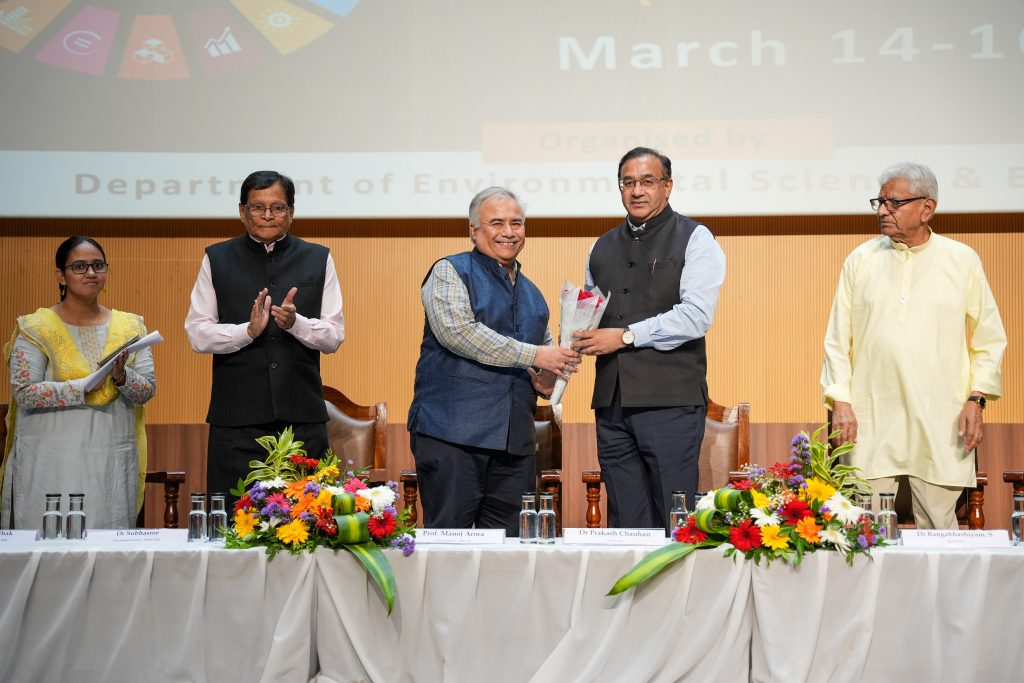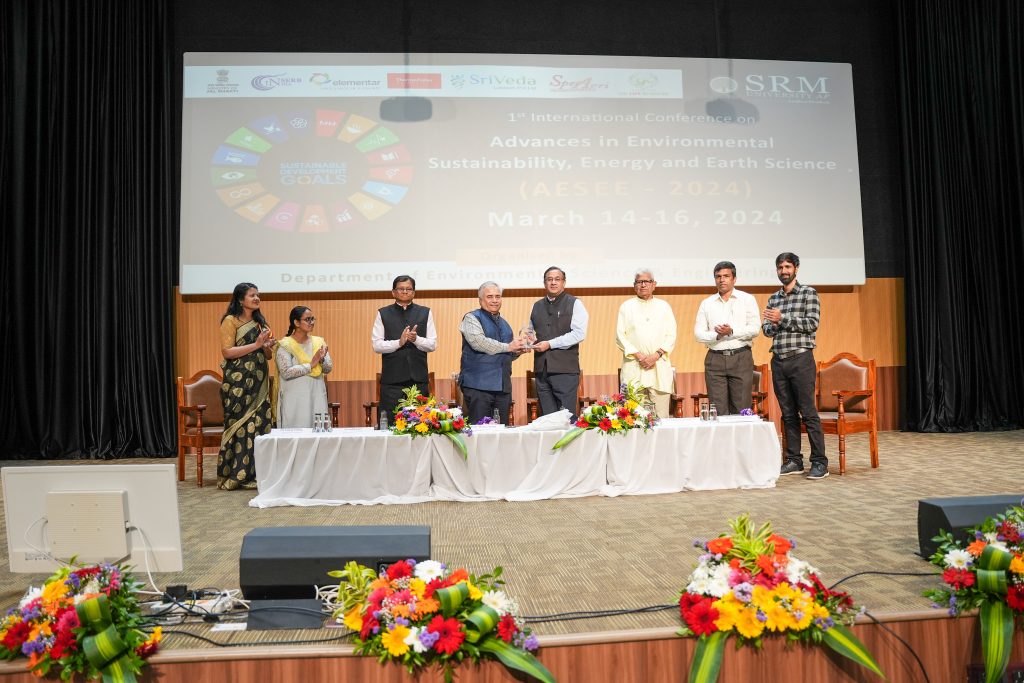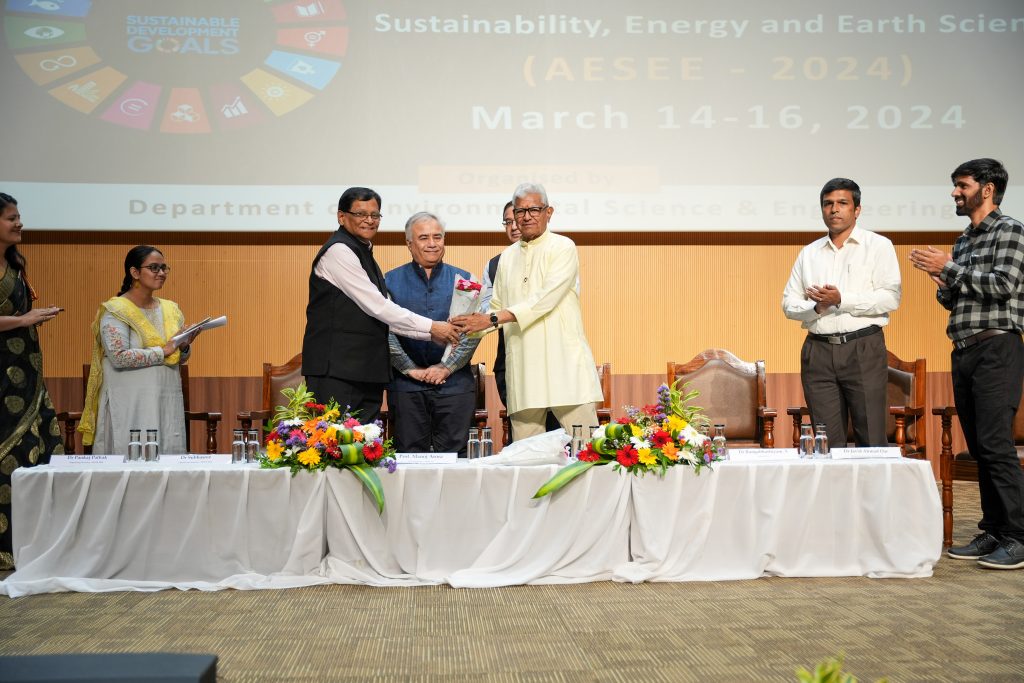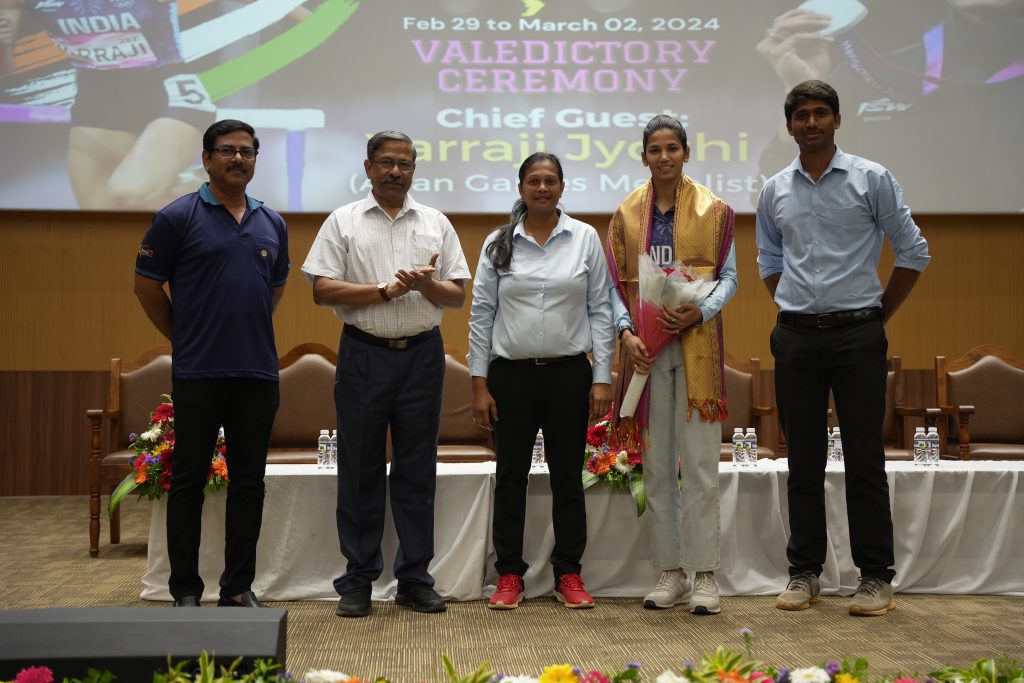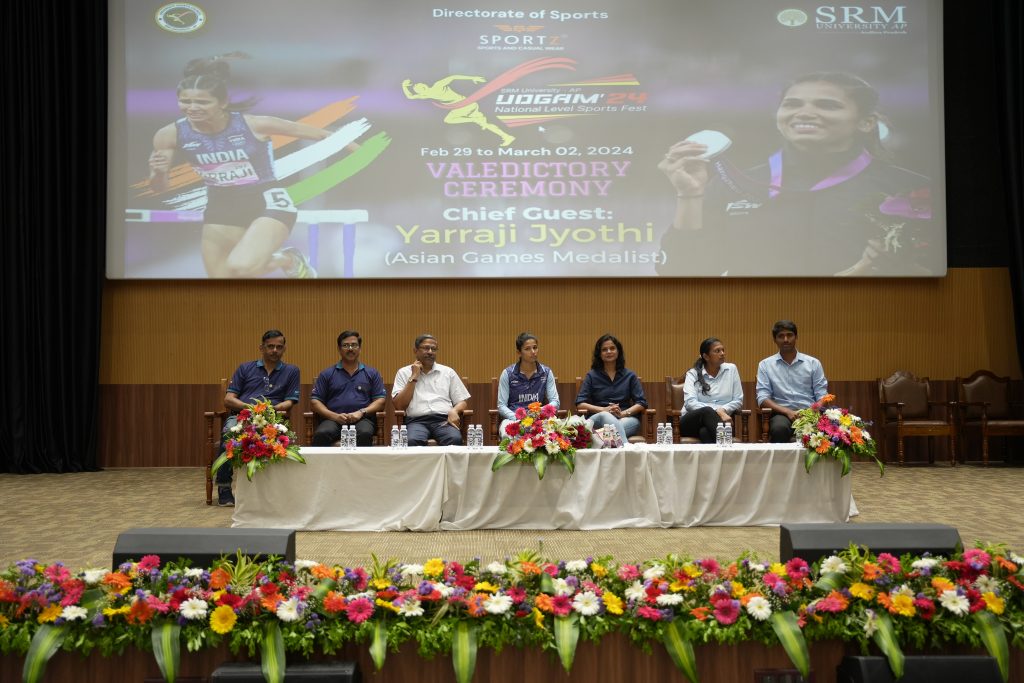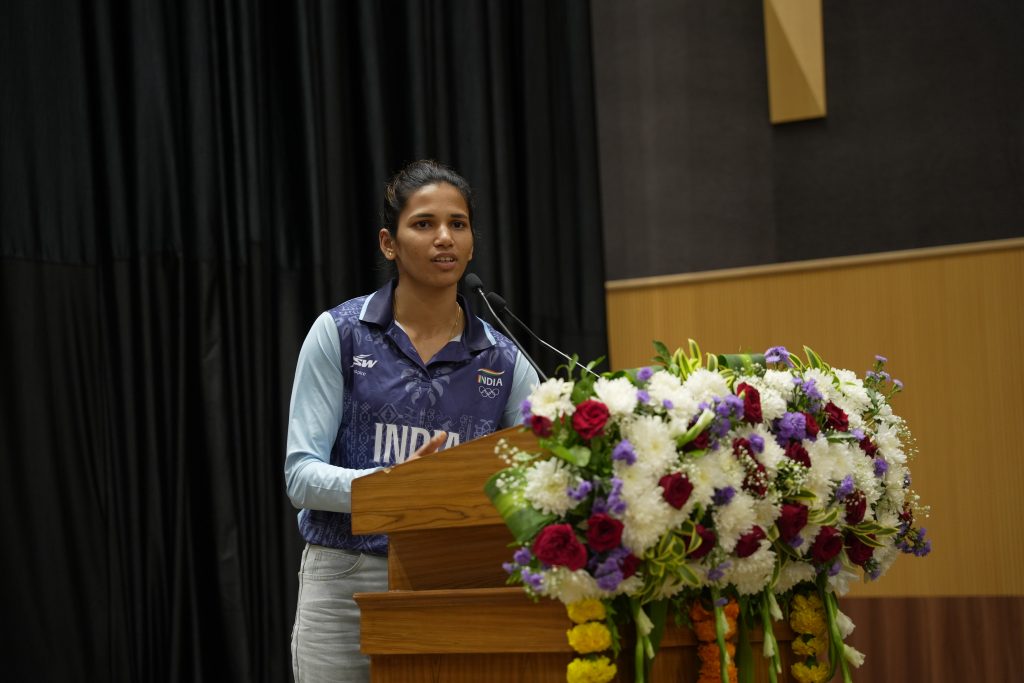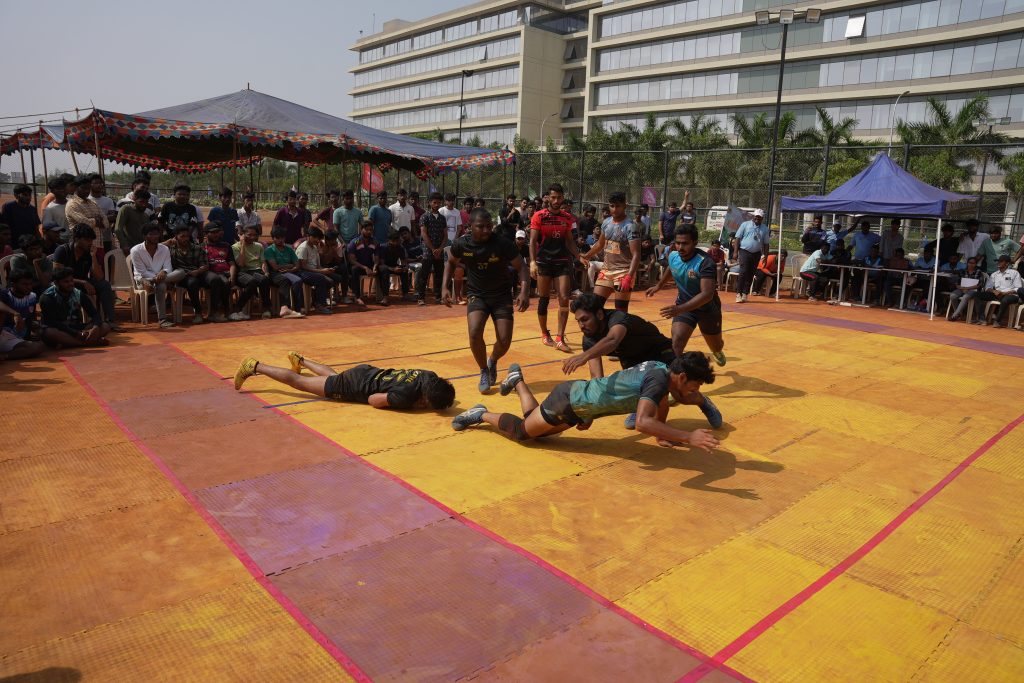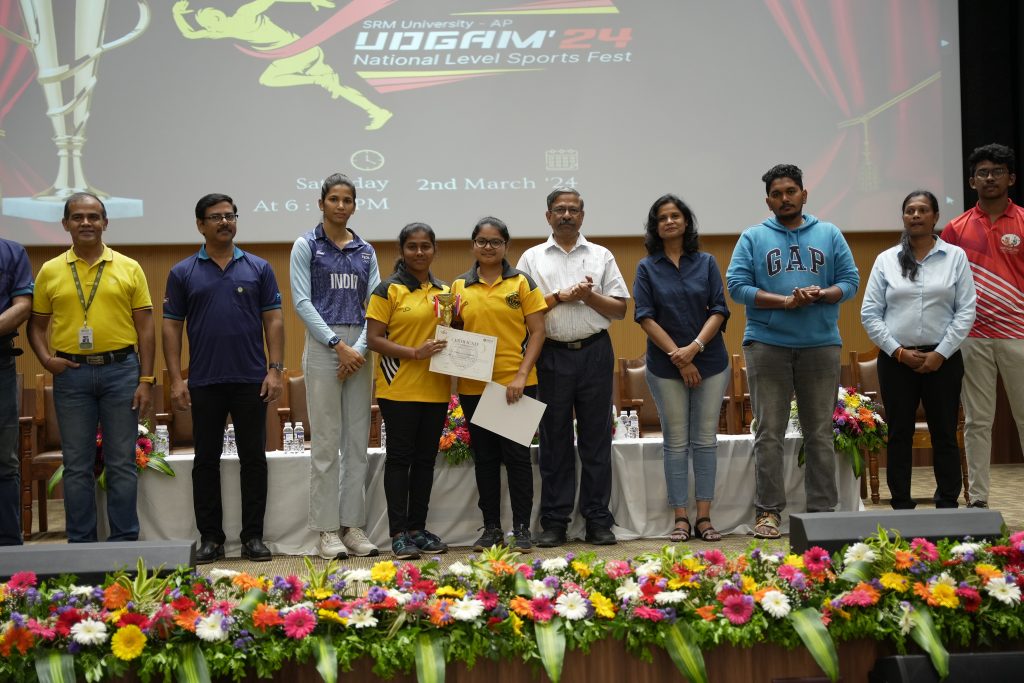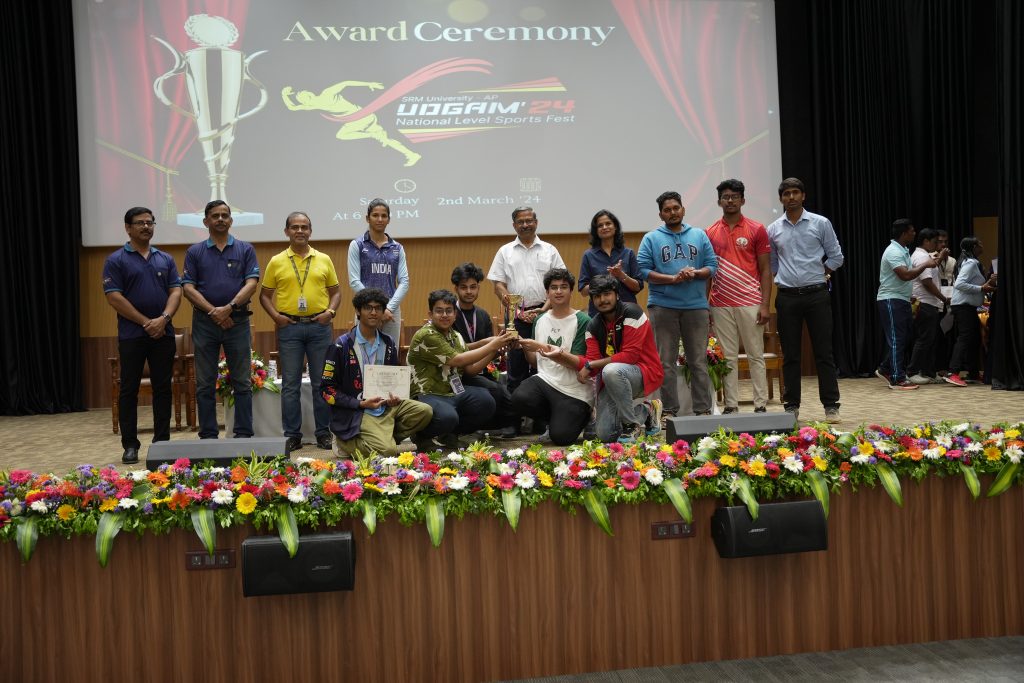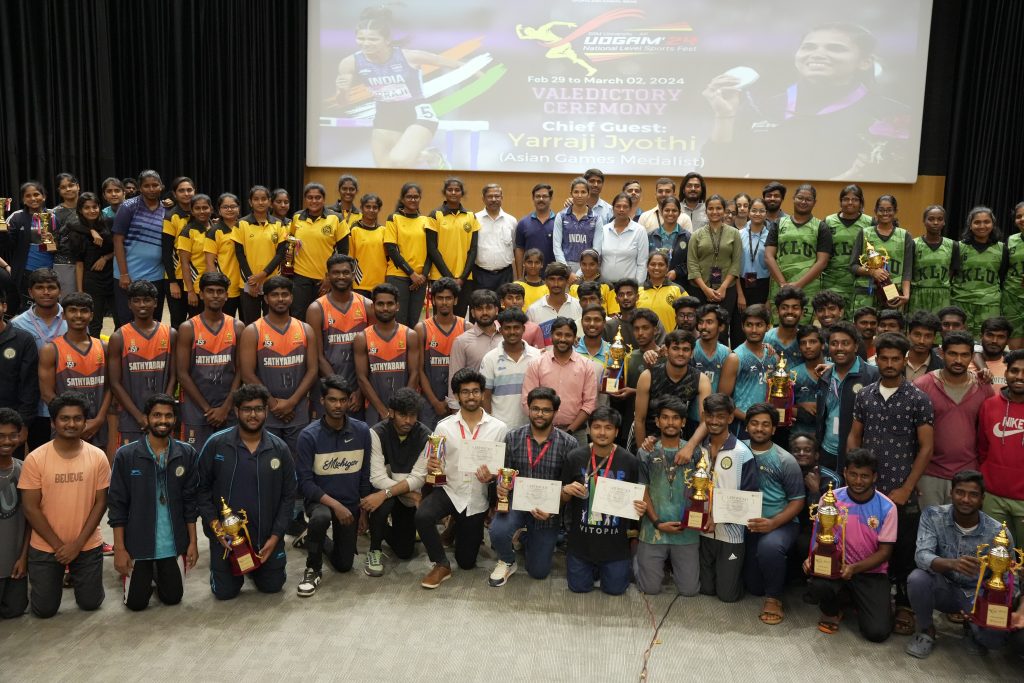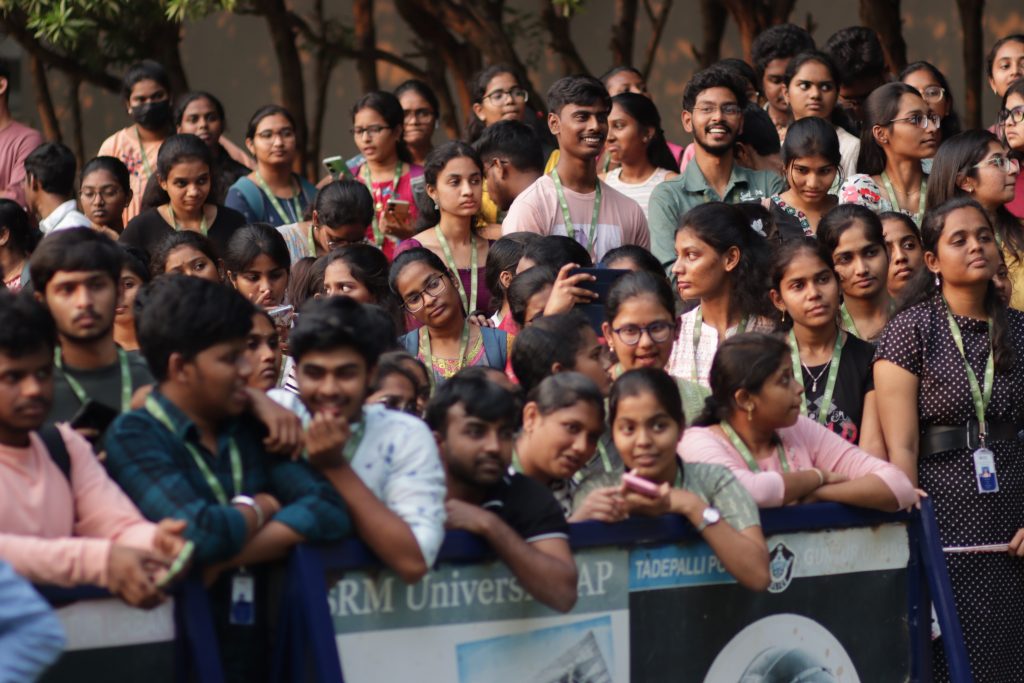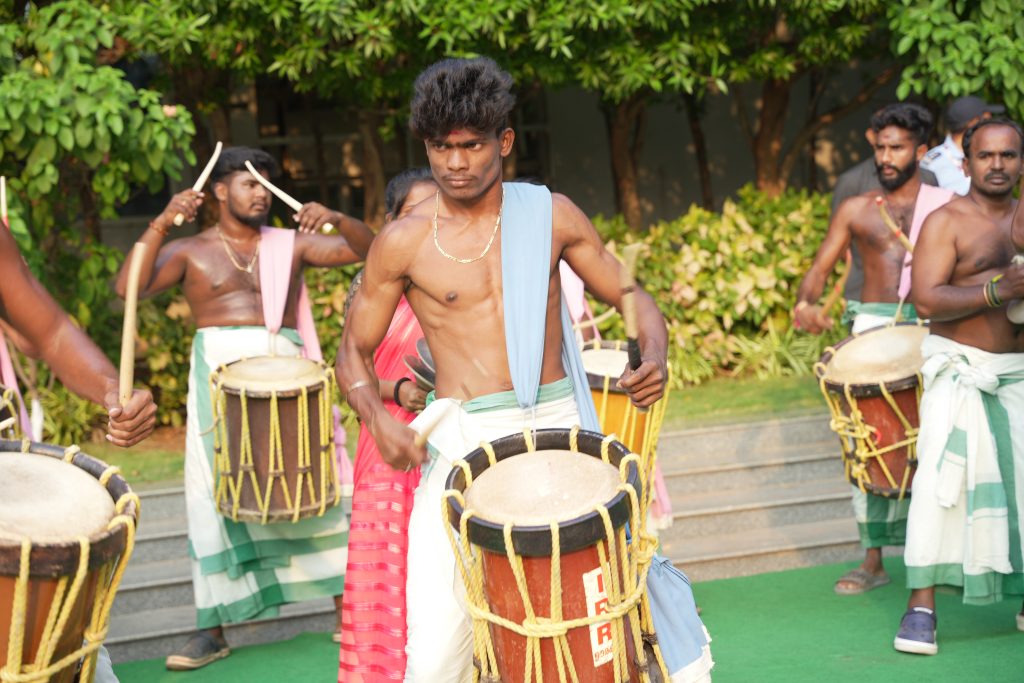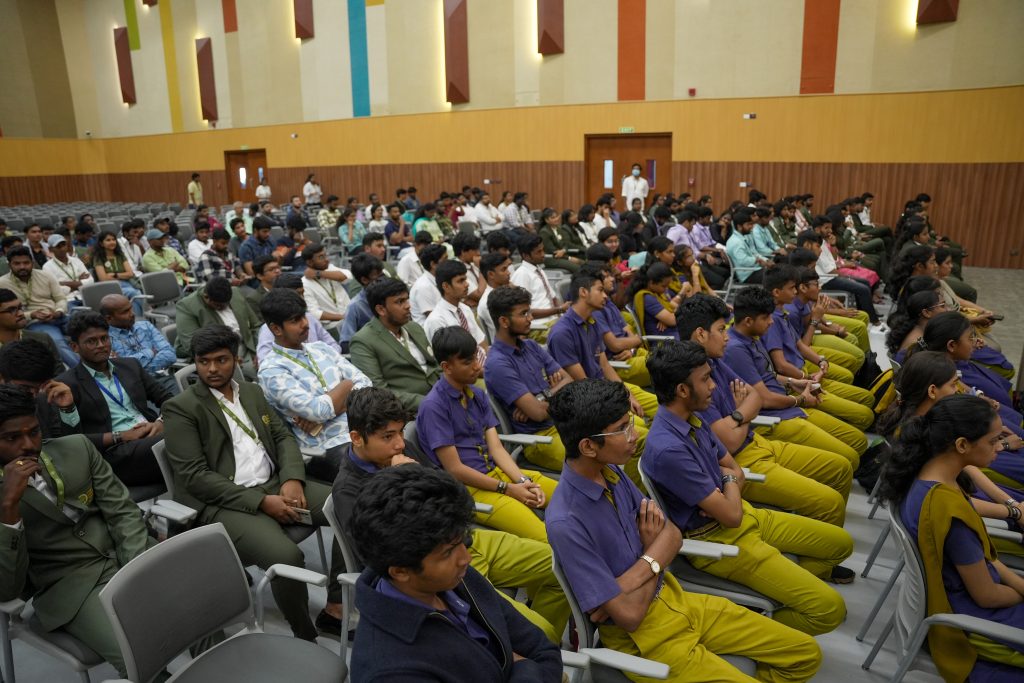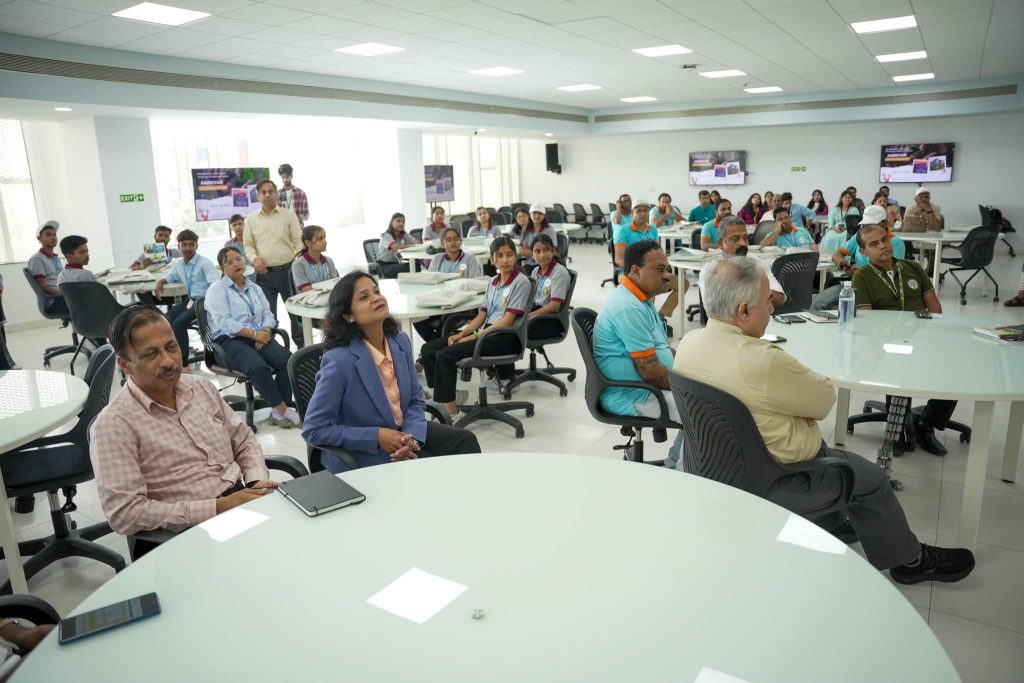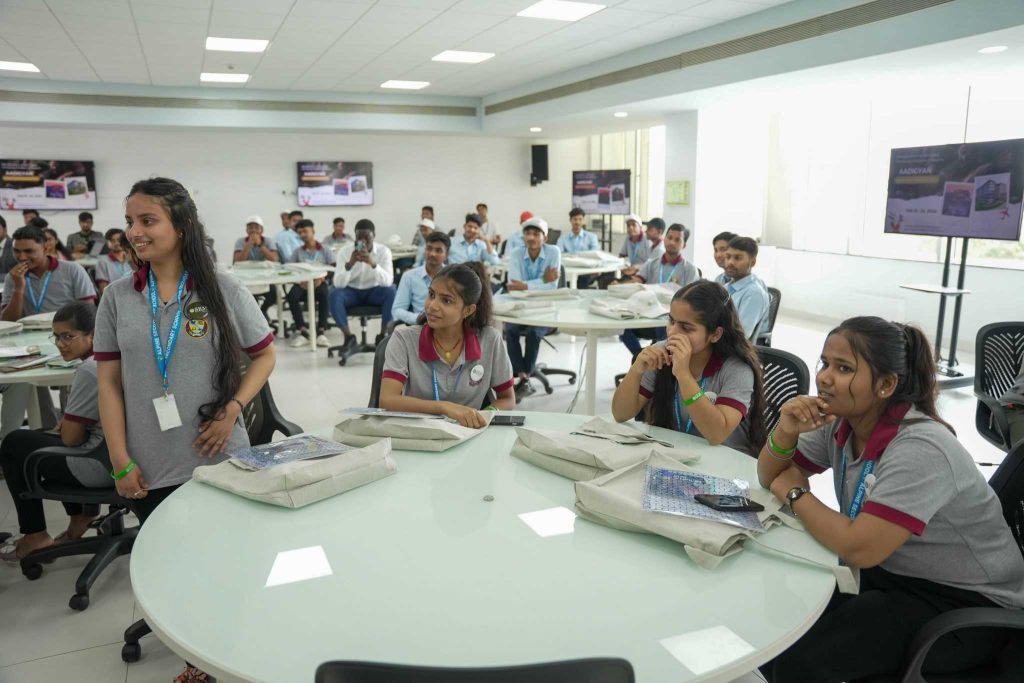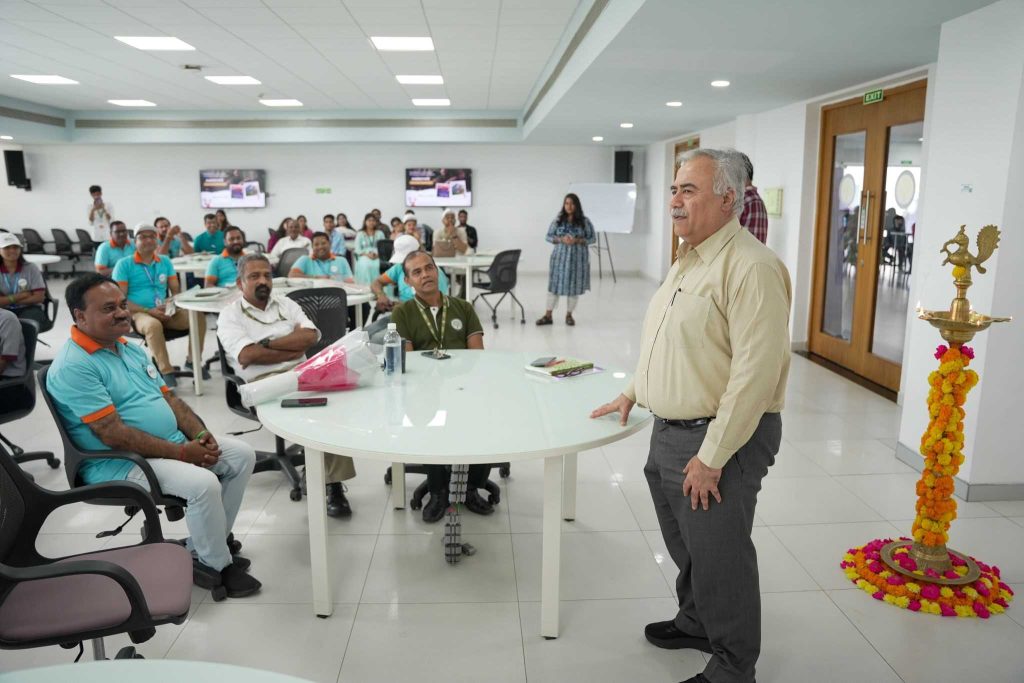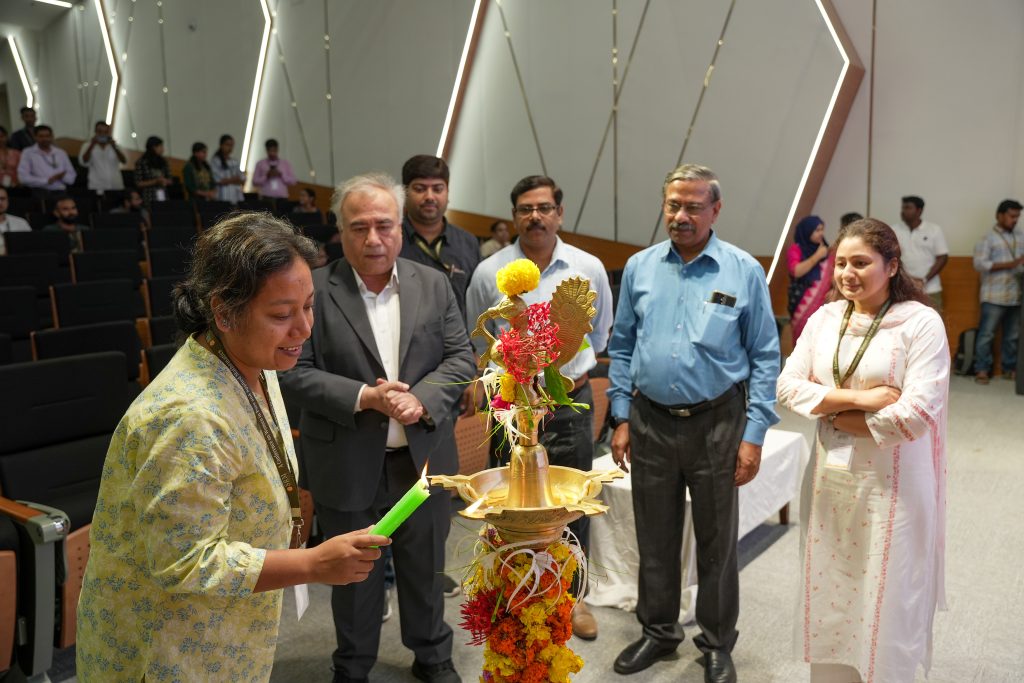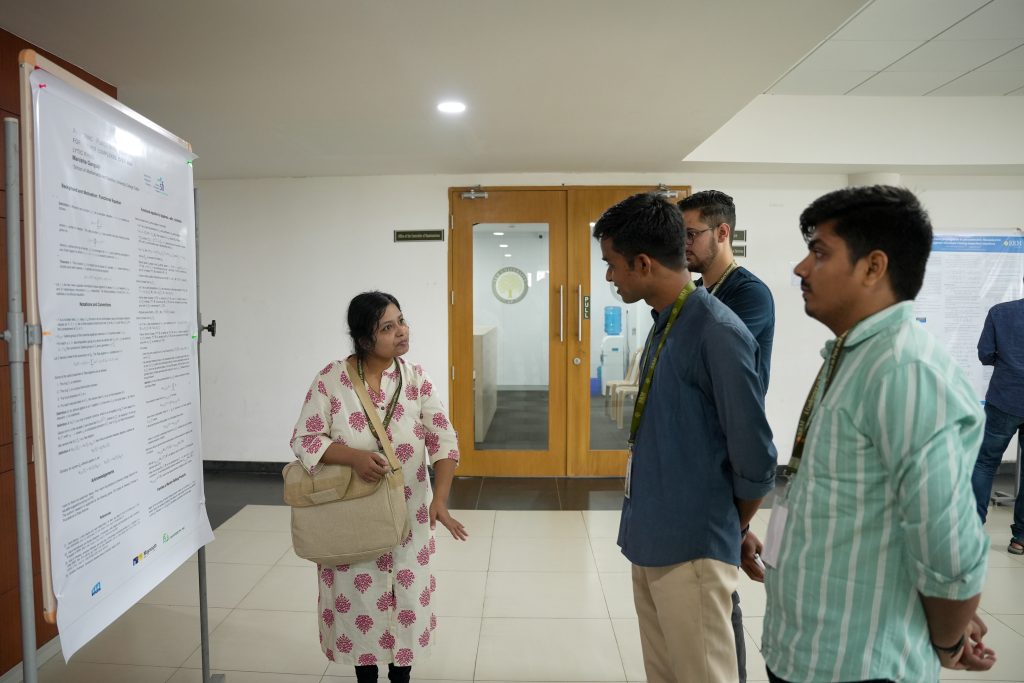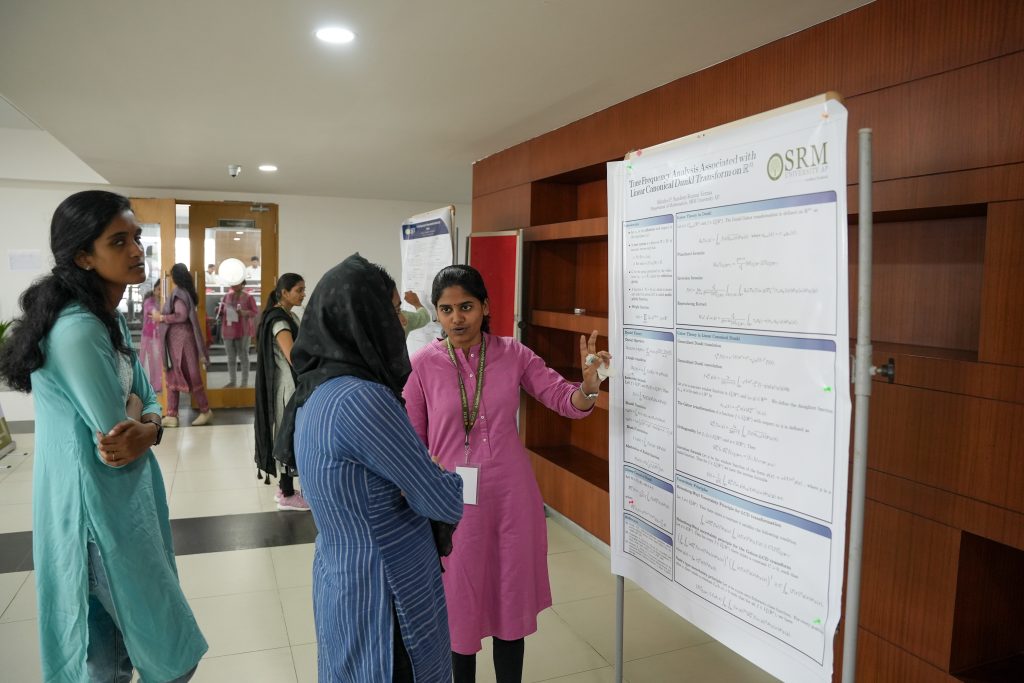AESEE ’24: Promoting Global Dialogue on Environmental Sustainability
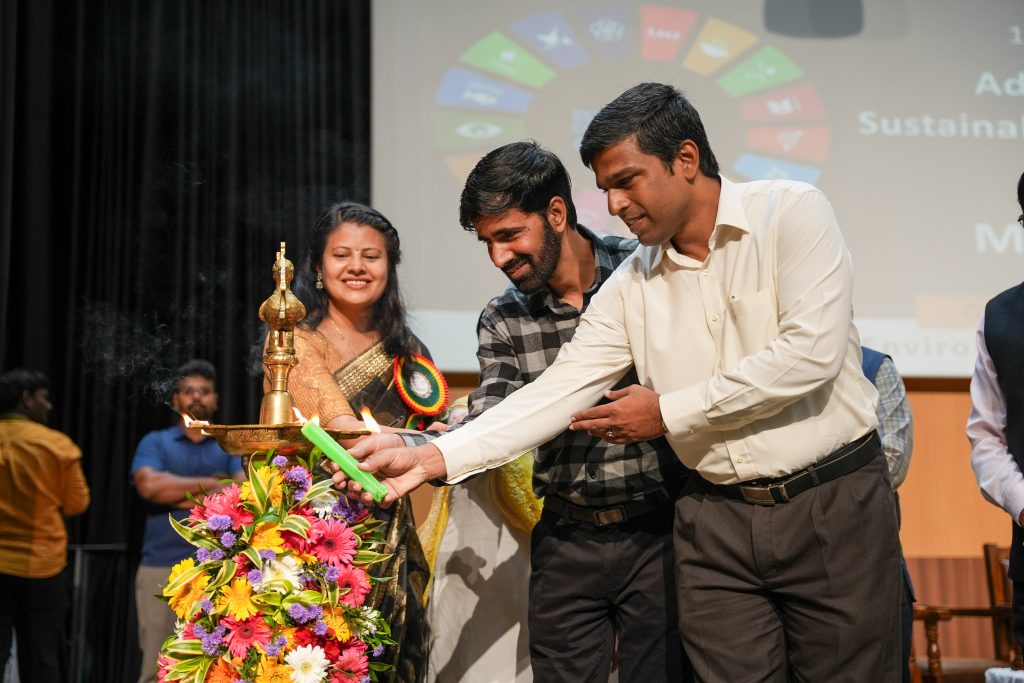
The Department of Environmental Science and Engineering at SRM University-AP organised its 3-day International Conference on Advances in Environmental Sustainability, Energy and Earth Sciences ( AESEE 2024). The inaugural session on March 14, 2024, featured industry experts, with Prof. Prakasham Tata from the Center for Transformation of Waste Technology, USA, as the Keynote Speaker and Dr Prakash Chauhan, Director-National Remote Sensing Centre, Indian Space Research Organization, as the Chief Guest for the event.
He highlighted the attributes of the department and lauded the efforts of the faculty and students who contributed to the publication of 165 articles, of which 106 were featured in Q1 Journals. This momentous occasion was witnessed by Vice Chancellor, Prof. Manoj K Arora; Advisor, Prof. V S Rao; Associate Professor and Head of the Department, Dr Rangabhasiyam Selvasembian; the organising secretaries, Dr Javed Ahmad Dar, Dr Pankaj Pathak and Dr Subashree Kothandaraman, along with participants from diverse parts of the globe, both online and offline.
Vice Chancellor-Prof. Manoj K Arora, in his address, emphasised that a congregation of such an intelligentsia is the need of the hour. He implored the audience to work at ground level and not confine themselves to mere talks and conferences, “go to the community and provide solutions, and solutions cannot be provided in the classrooms alone”, he stated.
Prakasham Tata, in his exuberant address, stated that the nation does not lack the intelligence or manpower to combat the alarming ecological crisis; It is the lack of trained personnel, pollution control boards, corruption and lack of effective cooperation between societal institutes that is causing a lax. Prof. Tata insisted that “universities like SRM AP are knowledge centres and have the tenacity and wisdom to combat the growing threats.” He issued a clarion call to all the youngsters and environmental enthusiasts to walk the talk.
Dr Prakash Chauhan, Director of the National Remote Sensing Centre, in his speech, cited Indians’ inherent way of living a sustainable lifestyle and went on to encourage the young participants in attendance to become true ‘karma yogis’ by innovating and finding new ways to promote and work towards environmental sustainability. He implored the youth to brainstorm innovative ideas that could gradually lead to monetisation opportunities while also benefitting the environment.
The inaugural day of the conference also marked the unveiling of the abstract book compiled by the department. Dr Javed Ahmad Dar, Assistant Professor and organising secretary of the conference, mentioned that the book consists of a total of 271 abstracts across 15 thematic areas. The event concluded with the Vice Chancellor and the Advisor honouring the guests with a token of appreciation.
- Published in Departmental News, ENVS News, News
ETSST 2024: Exploring the Next Frontier in Supra Molecular Technology
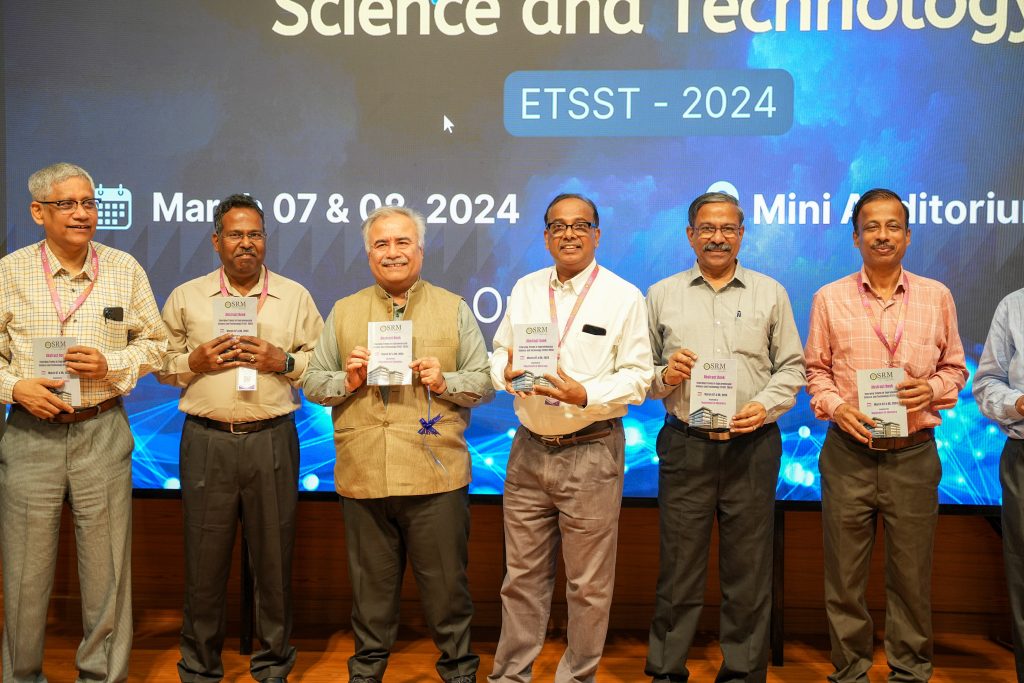
The Department of Chemistry at SRM University-AP has taken a significant initiative by organising an International Conference on “Emerging Trends in Supramolecular Science and Technology” (ETSST-2024) on March 07 and 08, 2024. This two-day conference brought together some of the most renowned and accomplished national and international intellectuals in the field of chemistry, who will share their insights and expertise on the latest advancements, emerging trends, and future prospects in the domain of supramolecular science and technology. The conference promises to be a great platform for researchers, scientists, academicians, and students to exchange ideas, network, and collaborate towards making breakthrough contributions in the field.
The conference marked the presence of academic stalwarts from institutes of national and international repute who expounded on the relevance of the conference and discoursed upon the various topics.
The event also featured the unveiling of the abstract book compiled by the department. Vice Chancellor, Prof. Manoj K Arora; Registrar, Dr R Premkumar; the Associate Dean- Science, Prof. Jayaseelan Murugaiyan; Chairman and Convenor ETSST-2024, Prof. C Pulla Rao; HoD- Chemistry, Dr Pardha Saradhi Maram; Dr Seema Rani and Dr Balaji Babu, Assistant Professors, Department of Chemistry, SRM AP bore witness to this momentous occasion.
At its core, the essence of this conference lay in its audacious objective – to unravel the enigmatic world of supramolecular science, where chemistry transcends the boundaries of individual molecules. It is a domain where complexity breeds innovation, and practical applications pave the way for unprecedented advancements in engineering and technology.
As the curtains drew to a close on this grand spectacle, the echoes of inspiration and collaboration continued to reverberate within the hearts and minds of all who were part of this transformative experience. The bonds forged and the knowledge shared during ETSST-2024 will forever shape the trajectory of supramolecular science and technology.
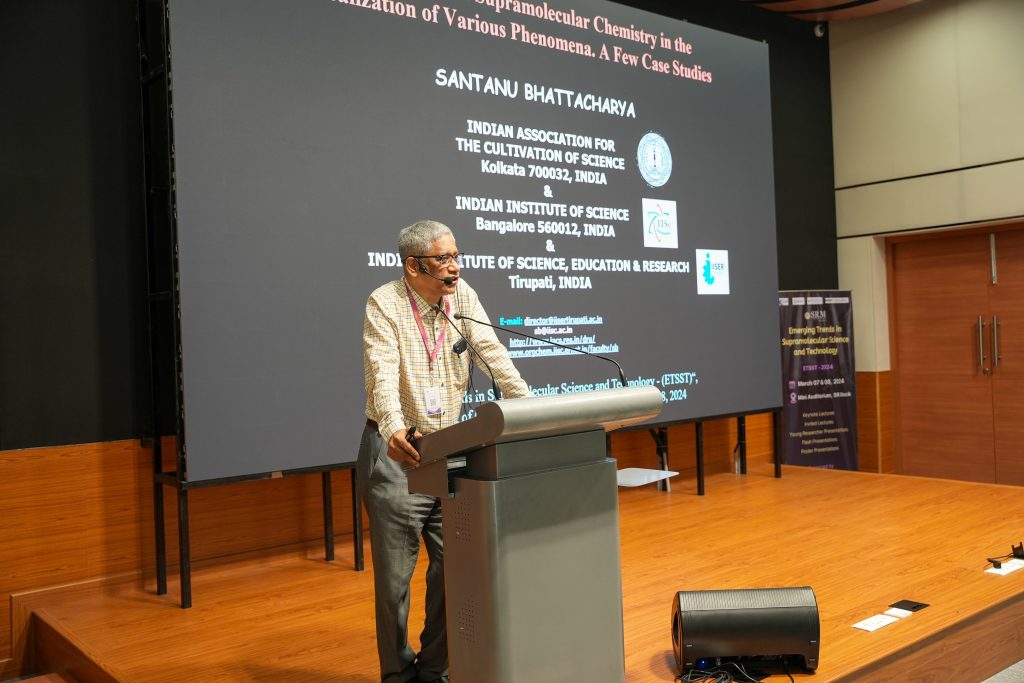
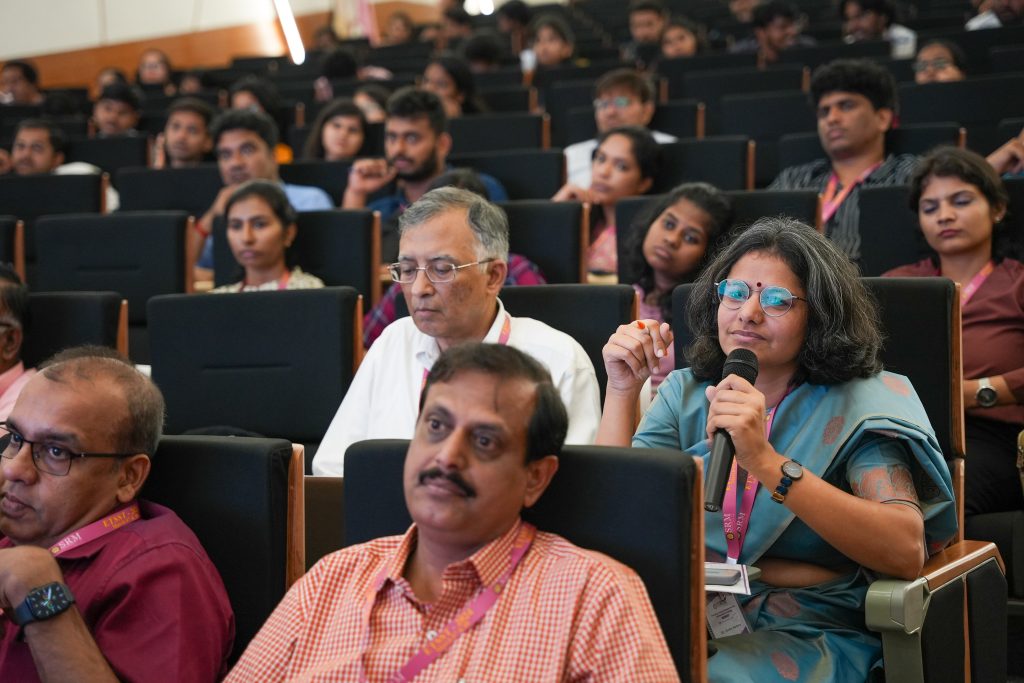
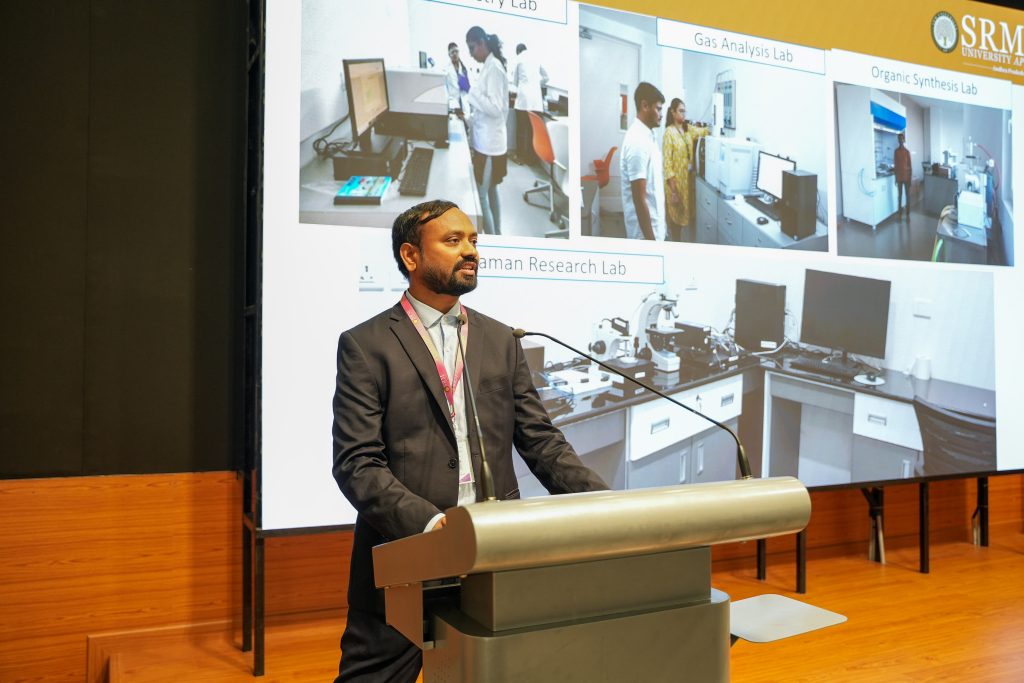
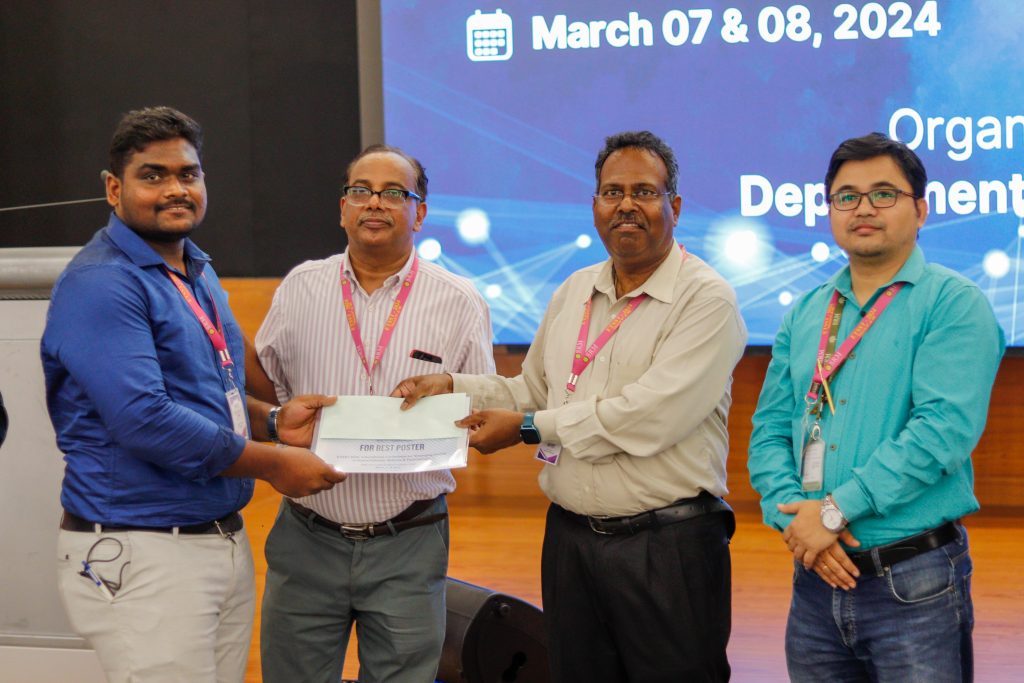
- Published in Chemistry-news, Departmental News, News
Promoting Well-Being in Children and Adolescents: A Holistic Guide to Mindfulness Strategies and Effects
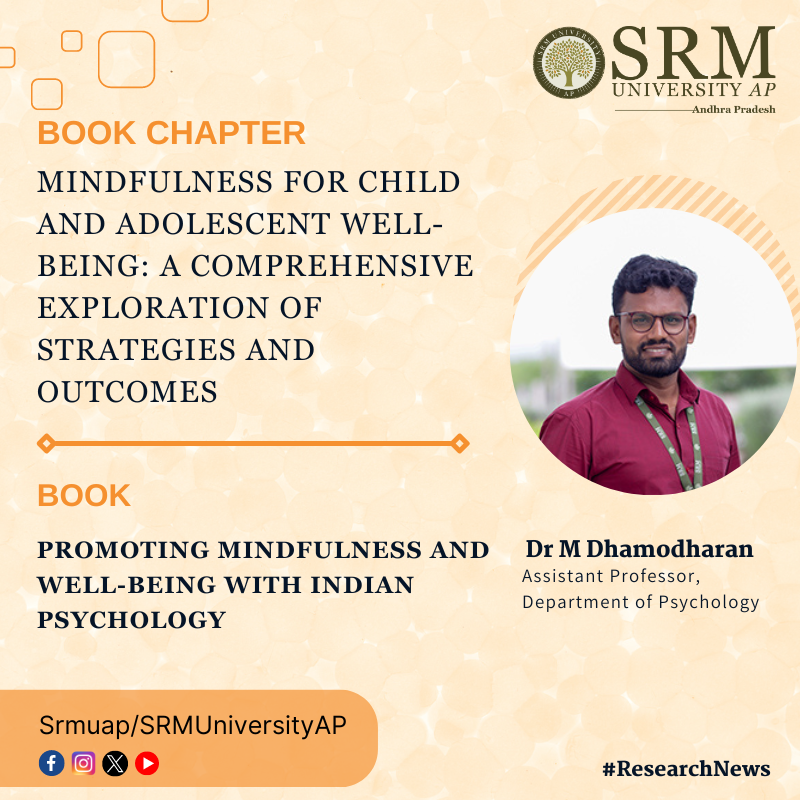
Mindfulness has emerged as a pivotal aspect in the domain of mental health, especially in the context of children and adolescents’ well-being. It refers to an inherent ability to be fully present in the moment, enabling an individual to gain an acute sense of awareness without any biases. Such a state of mindfulness empowers individuals to navigate the ups and downs of life with clarity and composure. Dr M Dhamodharan, an Assistant Professor in the Department of Psychology, has published a book chapter titled “Mindfulness for Child and Adolescent Well-Being: A Comprehensive Exploration of Strategies and Outcomes,” where he has comprehensively explored the intricacies of mindfulness and its impact on children and adolescents.
Here’s an abstract of the chapter published in the book, “Promoting Mindfulness and Well-Being with Indian Psychology.”
About the book chapter
The chapter examines the significant impact of mindfulness on children and adolescents. Mindfulness is the mental state defined by greater concentration, consciousness, and focus on the here and now, free from judgment. This chapter starts with the theoretical background of mindfulness and the current developments of mindfulness related to children’s and adolescents’ wellbeing. There are three main domains focused on mindfulness. Begin with emotional domains—that explains how mindfulness helps to regulate emotions. Secondly, cognitive domains explain how mindfulness practices help cognitive development and academic performance in educational settings. Thirdly, social and interpersonal domains explain the uses of mindfulness to improve social skills and interpersonal relationships with peer groups, family, and society. The chapter concludes with the role of parental and educational institutions in promoting mindfulness among children and adolescents to create a positive impact on their lives.
Dr Dhamodharan’s book chapter is targeted at Educators, parents, counsellors, and mental health specialists who stand to gain invaluable insights from the exploration of mindfulness within these pages.
- Published in Departmental News, News, Psychology News, Research News
Advances in Electric Vehicle Technology: A Study on Bi-Directional Converters
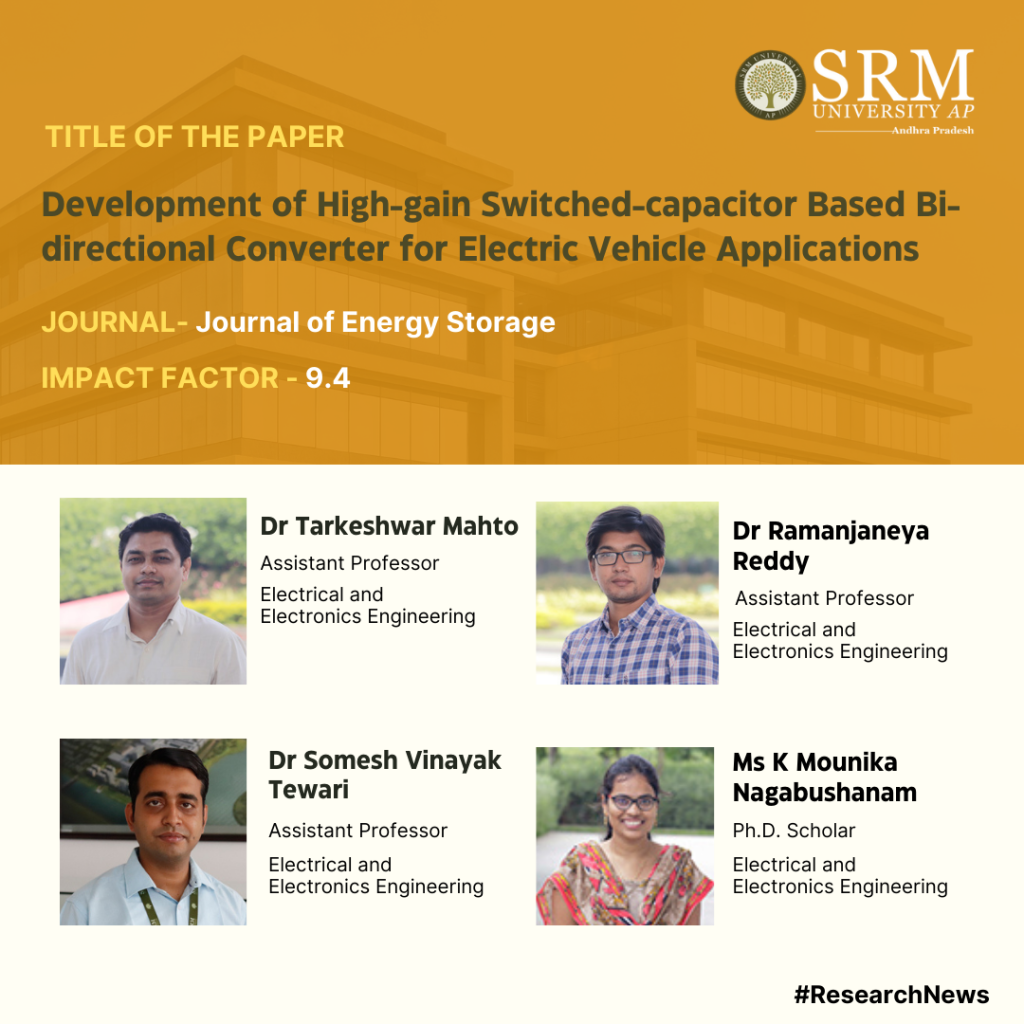
Electric Vehicles are in vogue today, thanks to the heightened environmental concerns, greater availability of models, increased cost competitiveness and improved vehicle ranges. To contribute to the growing field of electric vehicle technology, Assistant Professors, Dr Tarkeshwar Mahto, Dr Somesh Vinayak Tewari and Dr Ramanjaneya Reddy from the Department of Electrical and Electronics Engineering at SRM University-AP along with the research scholar, Ms K Mounika Nagabushanam, conducted a study and published a research paper titled “Development of High-Gain Switched-Capacitor Based Bi-Directional Converter for Electric Vehicle Applications.” The team’s research focuses on creating a bi-directional DC-DC converter that enables power flow from the battery to the motor and vice versa while maintaining necessary voltage gains and ensuring improved efficiency and low cost.
Abstract
High efficiency, high voltage transfer ratio (VTR), and low input ripple current are required in any bidirectional DC-DC converter (BDC) that plays a major role in interfacing batteries in applications like DC microgrids and electric vehicles (EVs). To meet these requirements, a switched capacitor-based BDC is proposed to interface the battery with a propulsion system via a DC Link. It has a simple circuit with only a set of switching operations, High VTR, and lesser ripple current on the low voltage (LV) side, which are advantages of the proposed High Gain Switched-Capacitor Bi-directional DC-DC Converter (SC-BDC), making it appropriate for use in EVs. The steady-state analysis, design consideration of passive components, loss and efficiency analysis are presented. Finally, the proposed High Gain SC-BDC is compared with a few of the existing BDCs in the literature. The feasibility of the converter was demonstrated by simulating a 200 W converter and validating results produced in a MATLAB environment.
Practical implementation of your research or the social implications associated with it.
The developed converter can be used in Electric Vehicle for integration of battery to traction motor.
Collaborations.
1. Majed A. Alotaibi, Department of Electrical Engineering, College of Engineering, King Saud University, 11421, Saudi Arabia.
2. Hasmat Malik, Department of Electrical Power Engineering, Faculty of Electrical Engineering, University Technology Malaysia (UTM), Johor Bahru 81310, Malaysia.
3. Fausto Pedro García Márquez, Ingenium Research Group, Universidad Castilla-La Mancha, 13071 Ciudad Real, Spain.
As part of their future research plans the team plans of working on noise reduction methods that are brought on by regeneration action and to incorporate various control techniques to keep the DC link voltage of the propulsion system constant.
We wish the team all success in their future endevours!
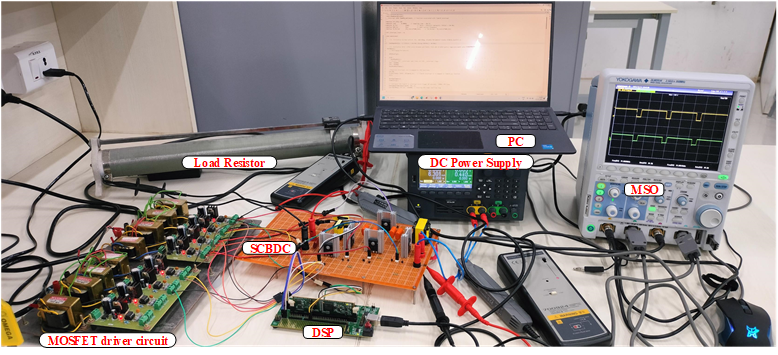
- Published in Departmental News, EEE NEWS, News, Research News
SRM University-AP Successfully Hosts UDGAM-’24, Celebrating National Sportsmanship
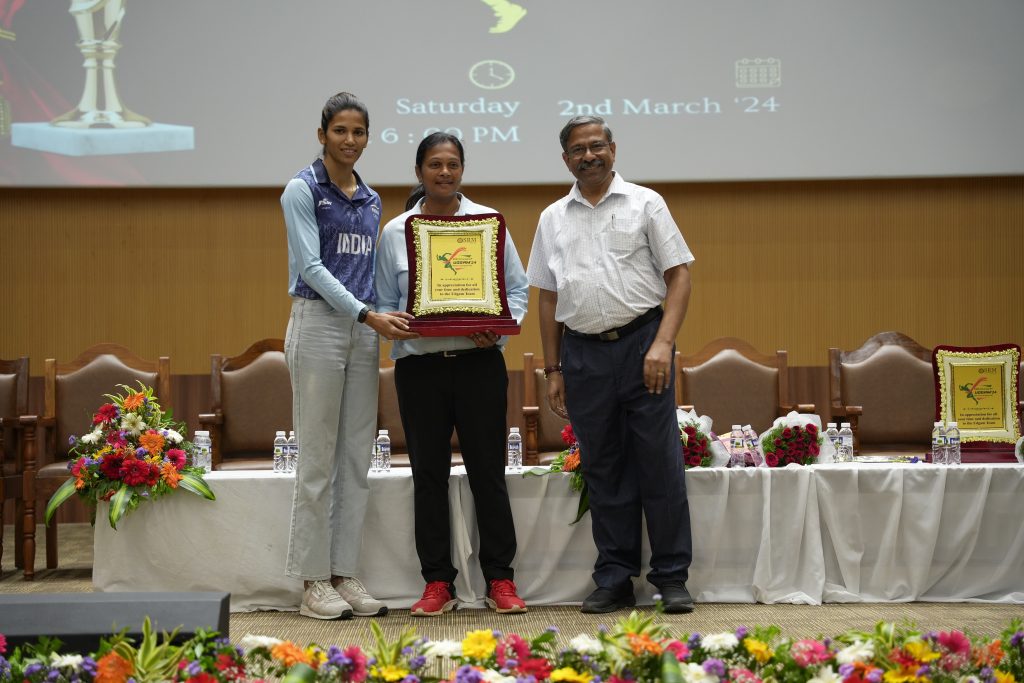
SRM University-AP, the proud organiser of the national-level sports event UDGAM-’24, graciously hosted a spectacular display of talent and sportsmanship on its grounds, wrapping up with a heartfelt closing ceremony on Saturday, March 2, 2024. The event, which commenced on February 29, was a testament to the spirit of unity and competitive excellence, with teams from across the nation showcasing their prowess in cricket, kabaddi, and volleyball.
The university extends its warmest congratulations to all the participating teams, especially highlighting the commendable performances of the Guntur Kits Engineering College cricket team, the kabaddi players from Amritasai Engineering College, and the volleyball teams from Saint Ann’s College and Mohan Babu University. Their dedication, skill, and sportsmanship have been the true highlights of this event.
SRM University-AP‘s grounds were alive with enthusiasm and energy, as athletes from various institutions came together to push their limits and celebrate the true spirit of sports. The cricket final was a particularly memorable moment, with the teams displaying exceptional talent and teamwork. The kabaddi and volleyball matches were equally riveting, filled with moments of sheer determination and exemplary skill.
The closing ceremony was a moment of unity and celebration, with Asian Games silver medalist Ms Jyothi Yerraji gracing the occasion to award the trophies to the deserving winners. The university’s registrar, Dr R Premkumar, led the event, emphasising the values of sportsmanship and camaraderie that Udgam- ’24 aimed to promote. The university also took the opportunity to express its gratitude towards all the participants, coaches, and supporting staff who contributed to the success of this grand sporting festivity.
In a humble acknowledgement of the collective effort, the university’s administration, including Dr Prem Kumar and Mr Anil Nigam, Director-Student Affairs, honoured the chief guest and all the participating athletes, appreciating their hard work, spirit, and the joy they brought to the SRM University-AP campus.
As we close this chapter of Udgam-24, SRM University-AP looks forward to fostering a continued legacy of sportsmanship, encouraging healthy competition, and nurturing the talents of young athletes from across the nation. We are inspired by the passion exhibited by all teams and are proud to have provided a platform for such a dynamic and inspirational exchange of athleticism and goodwill.
- Published in Departmental News, News, Sports News, University Event
Ameya’24 – Igniting Minds, Fostering Innovation
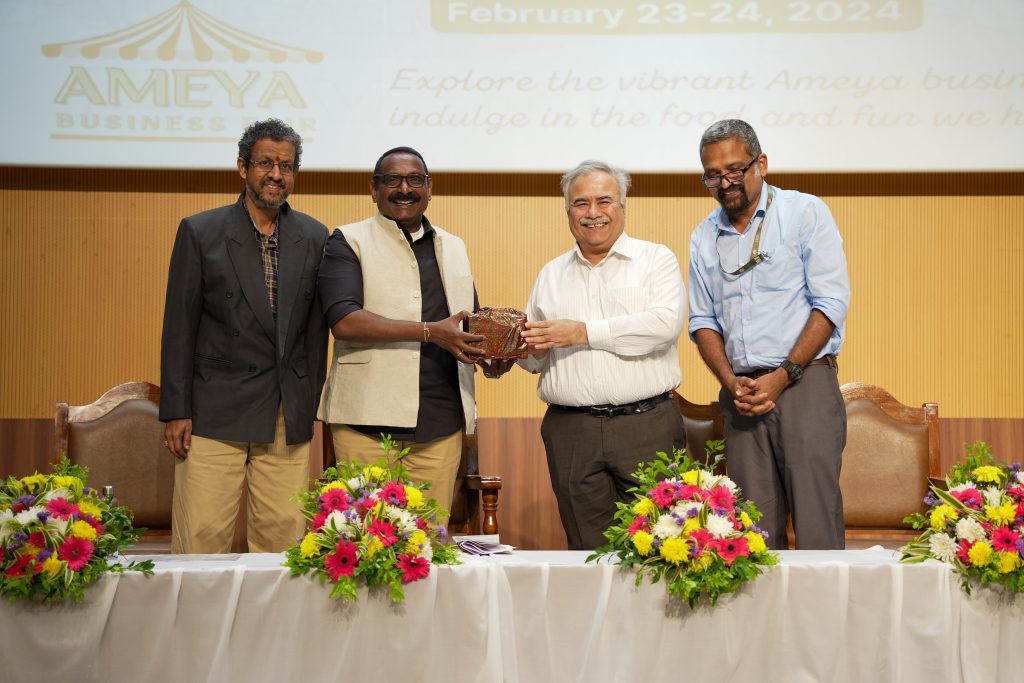
In the heart of the evolving business landscape, the Paari School of Business at SRM University-AP hosted the national-level business fest, Ameya ’24, a beacon of excellence and innovation, on February 23-24, 2024. This pioneering event, co-sponsored by Amyra Silver, was a crucible of ideas, leadership, and entrepreneurial spirit, attracting over 500 participants from 25 distinguished institutions.
The fest was inaugurated by an illustrious panel comprising Dr Bhanu Prakash Reddy Varla, a vanguard of entrepreneurship and chair of TiE Grad; Prof. Manoj K. Arora, the visionary Vice-Chancellor of SRM University-AP; Prof. Bharadhwaj Sivakumaran, Dean of Paari School of Business; and Prof. Vishnupad, Dean of Easwari School of Liberal Arts. Their presence underscored the fest’s commitment to blending academic rigour with real-world business acumen.
Empowering the Future: Leadership and Learning
Ameya ’24 was more than an event; it was a dynamic platform designed to instil leadership, team-building, and ethical decision-making skills among students. Prof. Manoj K. Arora highlighted the university’s dedication to offering experiences beyond traditional curricula, aiming to nurture a generation of dynamic entrepreneurs and professionals through unique courses such as Samaj Seva, Mind and Soul Training, and Happening Happenings.
A Journey of Inspiration: Dr Varla Bhanu Prakash Reddy
The chief guest, Dr Varla Bhanu Prakash Reddy, in his motivational address, shared his entrepreneurial odyssey, emphasising the importance of focus, skill accumulation, and horizon-broadening during graduate studies. Dr Reddy’s vision of an “Unstoppable India” leading the global economy, underscored by the rise of Indian unicorns, was a rallying call for students to become innovators and job creators, armed with SWOT analysis and upskilling from their student life.
A Kaleidoscope of Competitions
Ameya ’24 unveiled a spectrum of competitions designed to challenge and inspire:
Stock Pulse: A thrilling online stock simulation that tested participants’ investment strategies. Jainam R Jain from Nalanda Vidya Niketan bagged the first prize in this segment.
Product Palooze: A creative marketing challenge where teams devised unique selling propositions for randomly picked products. Praveen from Laki Reddy Bali Reddy College of Engineering became the winner.
Biz Wiz: A business quiz that spanned various domains, from CEO Showdown to Rapid-Fire rounds, engaging teams in a test of knowledge and wit. The winner of this competition was Venkata Yashwith Chakirala from Nalanda Vidya Niketan.
Elevator Pitch: An intense competition where individuals pitched fictional startups, showcasing their strategic thinking and persuasion skills. Shreeyash from SRM University-AP secured the winner rank in this one.
HR Odyssey: A deep dive into the future of Human Resource Management, with simulations and debates to test participants’ innovative HR solutions. Meghana from the Gates Institute of Management received the winning trophy in the competition.
Data Dynamo: A challenge that highlighted the importance of data visualisation and business intelligence, culminating in a real-world case study competition. Polavarapu Priyansha from SRM University-AP bagged the winning trophy in this segment.
IPL Auction Spectacle: A strategic game of cricket team building within a simulated budget, engaging participants in the intricacies of player selection and financial management. The winning position was secured by Suresh and Team from PB Siddhartha College of Arts and Science.
The business fair, a simulation of entrepreneurship, allowed students to experience the journey of setting up and managing a business through innovative kiosks, further enriching their learning experience.
Cultural Vibrance and Legacy
The fest also celebrated cultural heritage, with Chenda Melam captivating the audience, and a vibrant cultural evening of dance and music marking the conclusion of Ameya ’24. This fusion of business acumen and cultural celebration underscored the holistic development fostered at the event.
Ameya ’24 was not just an event but a milestone in the journey of future business leaders. It was a testament to the power of collaboration, innovation, and vision in shaping the entrepreneurs of tomorrow. As participants departed, they carried with them not just the memories of competition and camaraderie but the spark to ignite their paths and contribute to an unstoppable India. This fest has truly set a benchmark for fostering a dynamic generation of entrepreneurs and professionals ready to take on the world’s business stages.
- Published in Departmental News, News, Paari Current Happenings, paari-events
Aadigyan: Connecting Cultures and Celebrating Diversity
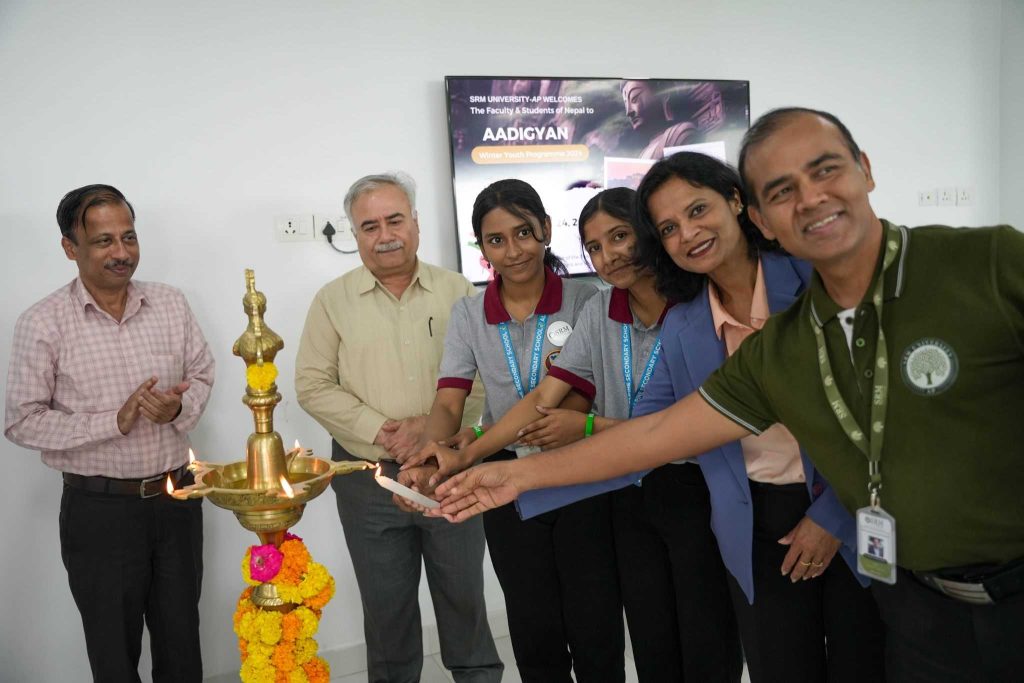
The Directorate of International Relations and Higher Studies (IR&HS) at SRM University-AP has organised Aadigyan Winter Youth Programme. The event is the varsity’s flagship initiative and is conducted to introduce International students and to familiarise them with the Indian culture, its history and lifestyle. This year the varsity hosted students and faculty from Alpine High School, Nepal. The event, which spanned over three days, saw students engage in the world of knowledge and innovation.
The induction featured Vice Chancellor, Prof. Manoj K Arora, Deans, Assistant and Associate Deans of the three schools, and Directors and other luminaries. The event highlights included insightful sessions on engineering, liberal arts, and a unique experimental workshop, “Walk with a Scientist”, that saw Prof. Jayaseelan Murugaiyan introduce the students to the vast diversity of flora and fauna on the campus.
The third day of the Aadigyan Youth Programme saw the students attend insightful sessions by luminaries such as Prof. A V S Kamesh, Professor Paari School; Mr Sidharth Shankar Tripathy, Director Entrepreneurship and Innovation; Ms Kriti Gopal Das, ISKCON and finally Ms Aditi Jain, Director-IR&HS.
- Published in Departmental News, IR-News, News
Innovating the Future: Patent Granted to Prof. Vinod Kumar and Dipak Bhosale
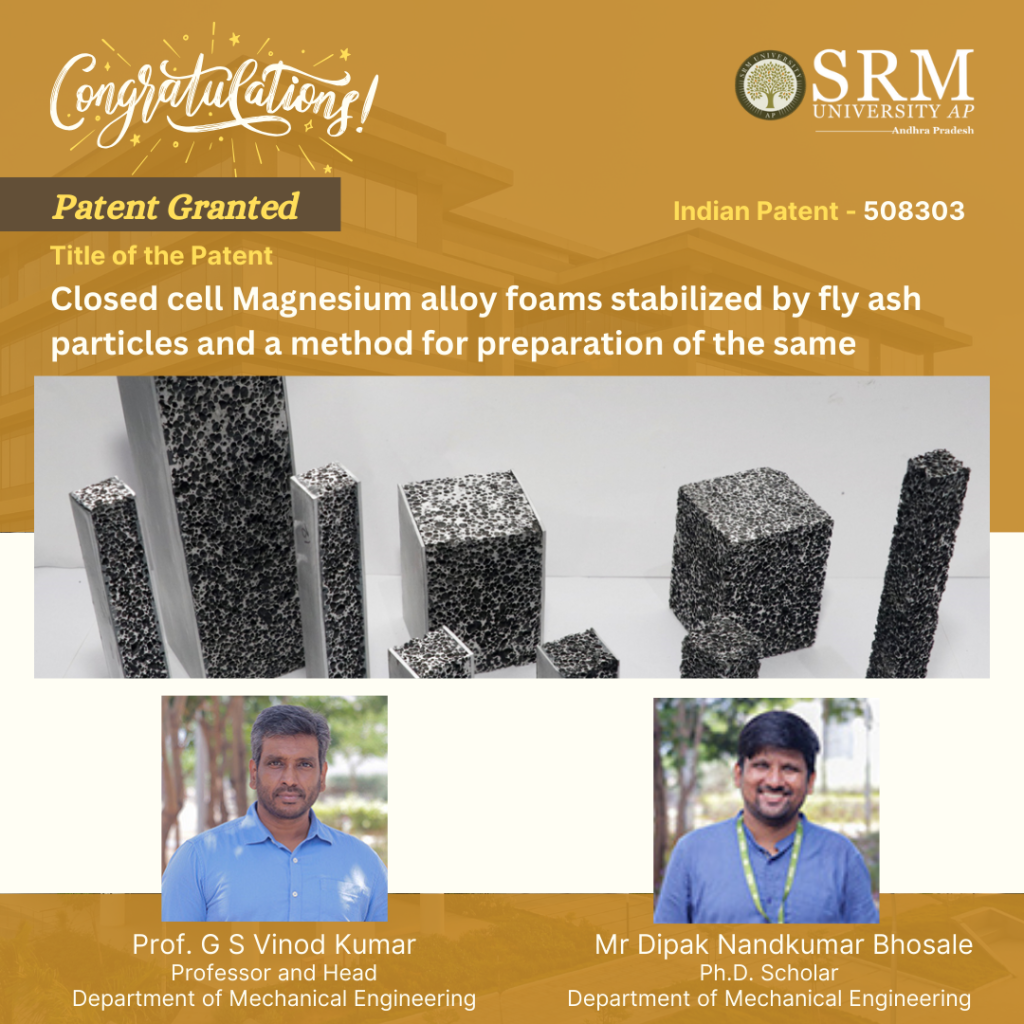
In the era of scientific advancement, Prof. G S Vinod Kumar, HoD and his Research Scholar, Dipak Nandkumar Bhosale, from the Department of Mechanical Engineering at SRM University-AP, shine as a beacon of inspiration. The teacher-student duo were granted a patent for their research titled “Closed Cell Magnesium Alloy Foams Stabilized by Fly Ash Particles and A Method for Preparation for the Same.” This patent stands as a testament to their relentless pursuit and unwavering commitment to science.
Kudos to Prof. G S Vinod Kumar and Mr Dipak Nandkumar Bhosale for their exemplary dedication and foresight. Here’s an abstract of their patent-winning research.
Abstract:
A magnesium metal foam product enhanced with fly ash particles demonstrates versatility across multiple applications, including space, automotive, civil engineering, and marine uses. The stability of this magnesium alloy foam is attributed to the incorporation of fly ash particles, particularly alumina silicate (Al2SiO5) cenospheres. These cenospheres, hollow spheres derived from fly ash, serve as effective stabilisers for the magnesium alloy foam. The preparation involves reinforcing magnesium foamable precursors with fly ash particles, facilitating optimal foaming. The presence of fly ash particles ensures the stability of the liquid foam until solidification, resulting in a foam with a superior pore structure. With a contact angle ranging between 70° to 90°, the particles exhibit prolonged interaction with the liquid metal without agglomeration, dissolution, or reaction. This characteristic contributes to the attainment of desirable qualities essential for diverse applications.
Practical Application:
1. Aerospace: Magnesium foams can be used in lightweight structural components, thermal insulation, and vibration-damping systems in aerospace applications.
2. Automotive: In the automotive industry, magnesium foams find applications in lightweight body panels, crash absorbers, and acoustic insulation.
3. Biomedical: Due to their biocompatibility, magnesium foams are utilised in medical implants, such as bone fixation plates, and as scaffolds for tissue engineering.
4. Energy: These foams can be employed in thermal management systems, heat exchangers, and as structural components in renewable energy systems.
5. Sports and Leisure: Magnesium foams can be used in sports equipment such as helmets, pads, and protective gear due to their lightweight and impact-absorbing properties.
Patent Grant Number: 50830
- Published in Departmental News, Mechanical Engineering NEWS, News, Research News
Building Beyond Boundaries: Enroll in BTech in Civil Engineering
Design, Build & Thrive with a BTech in Civil Engineering
The field of civil engineering is experiencing a surge in demand. According to the Bureau of Labor Statistics, there’s an anticipated 5% growth in civil engineering employment from 2022 to 2032, surpassing the average for all occupations. On average, approximately 21,200 job opportunities for civil engineers are expected each year throughout the decade.
Civil engineering professionals are involved in designing and building various infrastructures, including buildings, bridges, water systems, and transportation systems. Additionally, they tackle environmental issues such as pollution and land use. So, if you wish to make your future in this field, you must go for the BTech in Civil Engineering degree.
At its core, BTech Civil Engineering is a comprehensive programme that delves into the principles, theories, and practical applications of civil engineering. Students are equipped with a profound understanding of structural engineering, geotechnical engineering, transportation engineering, environmental engineering, and water resources engineering. Let’s have a look at the eligibility criteria and the duration of the BTech in Civil Engineering course.
B.Tech Civil Engineering Eligibility
The requirements for admission to a BTech programme in Civil Engineering can differ among institutions. However, common eligibility criteria typically encompass:
.Attaining a minimum of 50% marks in Mathematics, Physics, and Chemistry/Biology during the 10+2 academic level
.Achieving an overall qualifying score of at least 50% in the 10+2 examinations
.Having an educational background in a Science-related stream
Various popular entrance exams for admission to B.Tech in Civil Engineering comprise TANCET, JEE MAIN, JEE Advanced, BITSAT, and VITEEE.
B.Tech in Civil Engineering Duration
The duration of a BTech in Civil Engineering typically spans four years. During these four years, students undergo a structured curriculum that combines theoretical learning with practical applications, culminating in the acquisition of a comprehensive understanding of civil engineering principles and practices. The program’s duration may vary slightly among institutions, but a four-year timeframe is the standard for most B.Tech in Civil Engineering programmes.
BTech in Civil Engineering Jobs
A Bachelor of Technology (BTech) in Civil Engineering opens up a wide array of job opportunities in various sectors. Here are some potential career options after BTech in Civil Engineering:
- Civil Engineer
- Structural Engineer
- Transportation Engineer
- Environmental Engineer
- Geotechnical Engineer
- Construction Manager
- Water Resources Engineer
- Urban Planner
- Project Manager
- Consulting Engineer
- Construction Estimator
- Researcher or Educator
These are just a few examples, and the versatility of a B.Tech in Civil Engineering allows graduates to explore and specialise in different areas based on their interests and expertise. Additionally, as the field continues to evolve, new and exciting job opportunities may emerge, especially with the increasing focus on sustainable and innovative engineering solutions.
Constructing Dreams, Shaping Futures: BTech Civil Engineering Course at SRM University-AP
The School of Engineering and Sciences at SRM University-AP, offers a Bachelor of Technology in Civil Engineering. The university places a strong emphasis on educating the upcoming cohort of civil engineers, recognising its pivotal role in enhancing services to society. The university’s mission and activities revolve around three key pillars: Teaching, Research, and Service. Each facet of this mission is driven by the overarching goal of improving the student experience. The School has witnessed a surge in research activities, aiming to provide undergraduate students with enhanced opportunities to emerge as exceptional leaders in their chosen fields.
Objectives of BTech Civil Engineering Course at SRM University-AP
Establishing a proficient pool of future civil engineering professionals is essential at both the postgraduate and undergraduate levels, catering to diverse sectors like private industry, government agencies, educational institutions, and research and development offices
Equipping students with the skills needed to operate as independent civil engineering consultants capable of addressing real-world challenges through their acquired management, analytical, and research abilities.
Instilling interdisciplinary knowledge, fostering innovation and entrepreneurship in a diverse educational environment.
Bringing It All Together
The BTech in Civil Engineering programme at SRM University-AP, is your gateway to a dynamic and rewarding career in a field that is witnessing substantial growth. With the anticipated surge in demand for civil engineers and the diverse career options available, pursuing this degree becomes a strategic investment in your future. Moreover, if you aspire to contribute to the design and construction of essential infrastructure, tackle environmental challenges, and become a leader in the field, now is the time to embark on your BTech in Civil Engineering journey at SRM University-AP. Explore the possibilities, and join us in building a world where innovation, sustainability, and excellence converge in the exciting realm of Civil Engineering at SRM University-AP. Your journey to becoming an exceptional leader in the field begins here.
- Published in Admissions, Blog, Engineering
Celebrating Women’s Achievements in Pure and Applied Mathematics

The Department of Mathematics had organised an International Conference on Women in Pure and Applied Mathematics (WPAM). The five-day-long conference featured luminaries in the field of Mathematics and was funded by three prominent Indian government research bodies: SERB, NBHM, and CSIR.
The event saw Prof. Raman Parimala, a renowned Indian Mathematician, acclaimed for her contributions to the field of Algebra. The Conference was held with the purpose of providing an empathetic platform for women mathematicians to present their cutting-edge research work and to share their concerns about the gender gap in mathematical science.
Prof. Sanoli Gun (President of Asian Oceanian Women in Mathematics), Prof. Vijaylaxmi Trivedi (Chairperson, Indian Women in Mathematics), and Prof. Anisa Chorwadwala (Member, Indian Women in Mathematics) motivated the students and provided the students with valuable inputs on how to pursue their career further in Mathematics. The luminaries also discussed activities conducted by their organisations to encourage established women researchers, women PhD scholars and advanced undergraduate-level women students in Mathematics.
During the conference, activities such as poster presentations were held to facilitate mathematical interaction between students. The conference ended with the hope that there will be more opportunities to organise similar events.
- Published in Departmental News, Math News, News


